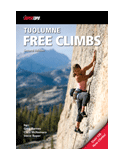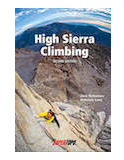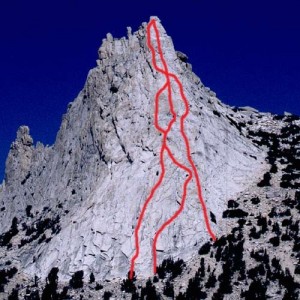Southeast Buttress, Cathedral Peak 5.6 |
||
Tuolumne Meadows, California USA | ||
| ||
|
Avg time to climb route: 2-4 hours
Approach time: 1.5 hours Descent time: 1.5-2 hours Number of pitches: 5 Height of route: 700' Overview
Cathedral Peak is one of the most aesthetic routes in Tuolumne. The climb consists of five pitches of easy and moderate crack and face climbing on perfect rock. The first few pitches are on low angle terrain that gradually steepens and becomes more difficult. Because of its quality and moderate grade, this is one of the most crowded routes in Yosemite. Luckily there are a number of variations if you need to pass a party.
Photos
- View all 127 photos of Southeast Buttress as: Thumbnails | Slideshow
Climber Beta on Southeast Buttress
Which SuperTopo guidebooks include a topo for Southeast Buttress?
Find other routes like
Southeast Buttress
History
John Muir didn’t take long to seek out the most beautiful peak of the Tuolumne region. On his first trip to the Meadows, in 1869, he strolled up through virgin forests (no John Muir Trail then!) and scrambled to the top of what he named Cathedral Peak. The last bit was bona fide class 4, making it the hardest climb yet done in the country. Muir said afterwards, “This I may say is the first time I have been at church in California.”Muir, naturally, chose the easiest way, and his was the only route on the peak for the next 76 years. Along came Chuck Wilts, one of the Valley giants of the 1940s. An electrical engineer, Wilts was fortunate to spend the war years on Army/Navy rocket projects in Southern California. This meant that he was able to get away often to climb in the Sierra. His wife, Ellen, herself a brilliant climber, remembers his gear, ancient indeed by modern standards: “tennis shoes, hiking boots and even, on occasion, nailed boots. His clothing consisted of army-surplus full-cut climbing pants, a pullover parka, and a brimmed shade hat.” Wilts and Spencer Austin often climbed in the Valley on weekends in the early 1940s, and they were almost the only people in the Valley, with climbers and tourists alike involved in the war effort. Super climbers, they were the first to free the Regular Route on the Higher Cathedral Spire (1944). Later (1946 and 1947) they made valiant attempts on the Arrow Chimney, only to lose the route to John Salathé and Ax Nelson. Virtually nothing is known about the history of the Wilts/Austin route on the Southeast Buttress of Cathedral Peak, even the year of the ascent. They never mentioned the climb in any major publication and, being modest men, never bragged about their soon-to-be classic route. The only clue—seven trivial words—appears in a mimeographed Sierra Club newsletter dated September 9, 1943, which states that in late July the pair “climbed the south side of Cathedral Peak.” This could well have been the route we are talking about. Whatever the year, it seems safe to say that they got the idea for their route by looking at that amazing profile of the buttress seen from many places along the Tioga Road east of the Meadows. It would be hard for a climber to scope that view and not want to be up there. Why no one had done the buttress in the 1930s is unclear, except that the pioneers back then usually sought out unclimbed summits rather than put up new routes. By the mid-1950s the route was a standard one, middling 5th class, and done by a few people on virtually every Sierra Club trip to Tuolumne. I did it when I was 16, in the company of an even-less experienced 17-year-old. We joyfully pounded our soft pitons into the decomposed cracks, taking hours (it seemed) to get them out, all twisted and scarred. Our excitement mounted as we got close to the top, manteling those big blocks of ultra-clean high-country granite. On top of our first “big” climb, we realized we had become rockclimbers as well as mountaineers. – Steve Roper Strategy
There are no real routes up the Southeast Face, just an incredible sea of features that can be pieced together in an infinite number of variations. Because the face often has 10-15 people on it at a time, it’s important to utilize these variations to avoid bottlenecks and slower parties. We highlight three main ways to climb the face, but you may create your own climb that combines pitches from all three. Route A gets most of the traffic, and although slightly easier it is no more classic than routes B and C. In fact, many pitches on routes B and C are considered the best on the face.To avoid crowds start early or, if you can climb fast, get a late start. Often if you start climbing before 8 a.m. or after 3 p.m. you will have most of the face to yourself. Because of the numerous climbers on the route, definitely wear a helmet and be careful of loose knobs and loose rock, especially 100 feet above The Chimney. The summit is a 10,940-foot lightning rod and it’s a miracle that no climbers have been killed by lightning. A climber was struck in summer 2000 and only luck and the Tuolumne SAR people were between him and the afterlife. Puffy clouds at the trailhead mean one thing: go climb something else! For those who finish early, an amazing, improbable, and short 5.4 route will take you to the top of Eichorn’s Pinnacle. Hopefully, you’ll have a friend to take pics because the spectacular picture of you on top of Eichorn’s Pinnacle, taken from the notch, is one to show off to family and friends. (See the SuperTopo for Eichorn’s Pinnacle for more info.) Before you start climbing, hang your backpack and any other gear in a tree as marmots will eat anything you leave at the base, including packs with no food. Retreat
High Sierra thunderstorms and lightning sneak up on many Cathedral Peak climbers; be prepared in case you have to retreat. It is possible to retreat with just one 50m or 60m rope. However, two ropes will make retreat much faster and require leaving less gear. Many perfect nut placements and natural threads/horns mean that even a multi-pitch retreat will be reasonable. Of course, if a thunderstorm is on you just leave the dang cams and live to zap some food in a microwave, instead of learning what it feels like yourself!To retreat from the base of The Chimney, walk right on the ledge, rappel off a slung flake (see topo) for two rappels with one 50m rope. If it’s getting dark and you just need to get to the top quick, there are many spots on Pitches 4 and 5 where you can bail off left onto 4th and easy 5th class terrain. Approach
Park on the side of Highway 120 at the Cathedral Lakes trailhead. Follow the John Muir Trail for about 8 minutes. The trail will bend right, ascend 30 granite steps and then cut left. After 200 feet, find a well-traveled, 3-foot-wide, sandy climbers’ trail that heads off left (about 15 feet before a stone runoff diverter and often blocked by logs so that tourists stay on the John Muir Trail). Follow this trail, most of which parallels Budd Creek, for about 45 minutes (1.5 miles) until the trail cuts right up a slope. The trail continues and gradually becomes more and more faint, at which point it’s obvious how to walk cross-country up to the base of the Southeast Buttress and the start of the climbing.Descent
From the summit, downclimb without a rope or downlead the final 20 feet. While this section is only 4th class, most will want a belay. The first climber should place pieces of pro intended to catch downward falls and clip them to the rope. Then the second will downclimb on lead, belayed by the first. You will be downclimbing the original line of ascent done by John Muir (without a rope and in heavy boots) in 1869.From below the summit, move away from the climbing route on 3rd class. Once on a big ledge, traverse 15 feet down right, then down LEFT for 150 feet on 3rd class ledges, then work back right on 4th class ledges and slabs. From the base of the ledges and slabs, walk north to a ridge. Walk the ridge for 100 feet and then drop down (3rd class) to heavily used sandy trails and hike back down to the base. Walk out the way you came in. Everything You Need to Know About
Tuolumne Meadows
Search the internet for beta on
Southeast Buttress
Links to related internet pages with info on Southeast Buttress
Other guidebooks that include info on Southeast Buttress
|
|







